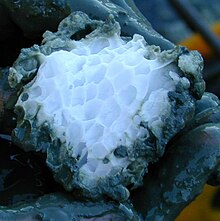
An abrupt climate change occurs when the climate system is forced to transition at a rate that is determined by the climate system energy-balance. The transition rate is more rapid than the rate of change of the external forcing,[1] though it may include sudden forcing events such as meteorite impacts.[2] Abrupt climate change therefore is a variation beyond the variability of a climate. Past events include the end of the Carboniferous Rainforest Collapse,[3] Younger Dryas,[4] Dansgaard–Oeschger events, Heinrich events and possibly also the Paleocene–Eocene Thermal Maximum.[5] The term is also used within the context of climate change to describe sudden climate change that is detectable over the time-scale of a human lifetime. Such a sudden climate change can be the result of feedback loops within the climate system[6] or tipping points in the climate system.
Scientists may use different timescales when speaking of abrupt events. For example, the duration of the onset of the Paleocene–Eocene Thermal Maximum may have been anywhere between a few decades and several thousand years. In comparison, climate models predict that under ongoing greenhouse gas emissions, the Earth's near surface temperature could depart from the usual range of variability in the last 150 years as early as 2047.[7]
- ^ Harunur Rashid; Leonid Polyak; Ellen Mosley-Thompson (2011). Abrupt climate change: mechanisms, patterns, and impacts. American Geophysical Union. ISBN 9780875904849.
- ^ Committee on Abrupt Climate Change, National Research Council. (2002). "Definition of Abrupt Climate Change". Abrupt climate change : inevitable surprises. Washington, D.C.: National Academy Press. doi:10.17226/10136. ISBN 978-0-309-07434-6.
- ^ Sahney, S.; Benton, M.J.; Falcon-Lang, H.J. (2010). "Rainforest collapse triggered Pennsylvanian tetrapod diversification in Euramerica". Geology. 38 (12): 1079–1082. Bibcode:2010Geo....38.1079S. doi:10.1130/G31182.1.
- ^ Broecker, W. S. (May 2006). "Geology. Was the Younger Dryas triggered by a flood?". Science. 312 (5777): 1146–1148. doi:10.1126/science.1123253. ISSN 0036-8075. PMID 16728622. S2CID 39544213.
- ^ National Research Council (2002). Abrupt climate change : inevitable surprises. Washington, D.C.: National Academy Press. p. 108. ISBN 0-309-07434-7.
- ^ Rial, J. A.; Pielke Sr., R. A.; Beniston, M.; Claussen, M.; Canadell, J.; Cox, P.; Held, H.; De Noblet-Ducoudré, N.; Prinn, R.; Reynolds, J. F.; Salas, J. D. (2004). "Nonlinearities, Feedbacks and Critical Thresholds within the Earth's Climate System" (PDF). Climatic Change. 65: 11–00. doi:10.1023/B:CLIM.0000037493.89489.3f. hdl:11858/00-001M-0000-0013-A8E8-0. S2CID 14173232. Archived from the original (PDF) on 9 March 2013.
- ^ Mora, C (2013). "The projected timing of climate departure from recent variability". Nature. 502 (7470): 183–187. Bibcode:2013Natur.502..183M. doi:10.1038/nature12540. PMID 24108050. S2CID 4471413.